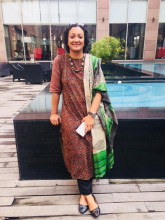Should we stay or should we go: Women in STEM on what helps them stay

For the past few years, on every International Women’s Day, I have thought of reasons I’ve known young girls or women give for choosing not to pursue a career in science, technology, engineering, and mathematics (STEM), despite their interest in these subjects. Take a career in biology for instance.
“Biology needs too much memorization, and I’m not good at memorizing stuff.”
“My family told me that working as a biologist in a lab would be too strenuous for me.”
“I wouldn’t feel safe doing fieldwork.”
Some of these may seem like valid reasons to give when striking out the option of studying a STEM subject. After all, these fields require significant hard work, patience, and creativity and, so, are already considered challenging to both get into and thrive successfully in. But for women, the challenges quite often multiply, for reasons social, structural, and personal. Any of the girls/women I’ve mentioned above may have just needed the right encouragement and support to become successful scientists—just the level their male counterparts may have received.
Once they do manage to begin a career in STEM, women have to contend with challenges that lead to the phenomenon of the leaky pipeline. Of course, women may leave STEM careers for reasons that are not gender-specific, such as interest in pursuing exciting opportunities elsewhere or lack of STEM opportunities themselves. But many departures tend to be related to gender biases and stereotypes, systemic discrimination, and inadequate organizational and social support systems.
To address this problem, we need to understand not only what drives women away but what helps them persevere. Today, we turn our focus around to what has helped women stay in STEM. We invited some women who've spent extensive time in research to share their views on what keeps or kept them going in STEM or STEM-related fields.
Dr. Eunyeong Song

Dr. Song has a Ph.D. in Chemical Biology from Xiamen University, China. She works as a senior scientist at Speclipse Inc., is a lecturer at Lingnan Normal University, and an academic trainer for Cactus Communications.
I am a chemical biologist and am proud of myself for having stayed in STEM. I do day-to-day lab experiments, conducting quantitative and qualitative research on biosensors. I play various roles: I’m not only a scientist in the lab but also a lecturer, trainer, writer, and reviewer. I like to come up with fresh perspectives on the topics I work on, and that gives me a great deal of pride in my work.
Supporting education and science initiatives for women is central to moving the world forward. We need a whole supportive community to raise one girl to become a woman scientist.
Dr. Smita Jain

Dr. Jain works as Associate Director, Academic & Government Relations (India), at Cactus Communications. She has a Ph.D. degree from the Indian Institute of Science, Bangalore, with a history of working in the biotechnology industry at the start of the career trajectory. She has 14+ years of experience in science promotion, communication, and business development. Prior to joining CACTUS, she led IndiaBioscience for five years.
What have always powered my move ahead are the passion for science, the purpose in life to work towards empowering the scientific community in India, the confidence instilled in me by my parents that “you can do it,” the support I have from my spouse, the energy that my kids infuse in me, the motivation I derive from my role models and mentors, and my self-belief that “nothing is impossible.”
A couple of women scientists shared their views with us in response to an invitation to do so on Twitter. Here's what they had to say:
Dr. Kate Dupuis
Schlegel Innovation Leader, Sheridan College
An extremely supportive spouse who takes on a lot of the heavy lifting in our home related to cooking, cleaning, and childcare during particularly busy parts of the semester/grant writing season.
— Dr. Kate (@DrKateTO) February 23, 2022
Dr. Kanchana Ayyar
Postdoctoral Research Associate, Boston Medical Center
Un-demanding spouse, tons of sacrifice, prioritizing STEM over most other things in life.
— Dr. Kanchana Ayyar (@Kanchana_PhD) March 1, 2022
One common factor that stands out in the views of all these women is support from their families/communities. Achieving gender equity and parity at all career stages in STEM will require changes in institutional structures and work policies. But perhaps, it will first require major changes in the way immediate social connections and networks view the contributions of women in STEM and stand behind women, propelling them forward.
Building interest and passion for these subjects at a young age is critical, but it is just as important to ensure that the momentum is sustained as women advance in their careers. The importance of societal/community support cannot be overstated. Young women should grow up with the confidence that their contributions will be as valued and sought-after as those of men in STEM and with the assurance that the society they are part of will support them equally.
If you are a STEM woman, we’d love to hear from you too about what helps you persevere. Drop us a comment below!
Comments
You're looking to give wings to your academic career and publication journey. We like that!
Why don't we give you complete access! Create a free account and get unlimited access to all resources & a vibrant researcher community.














